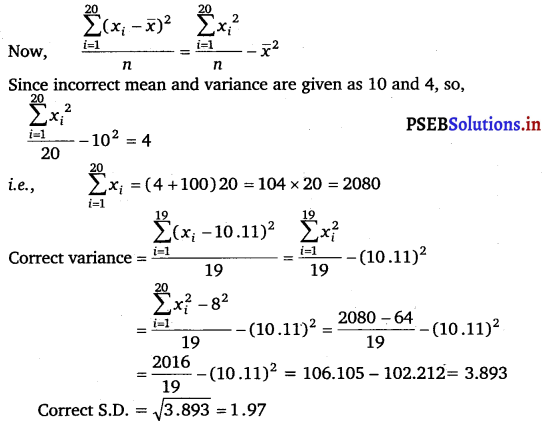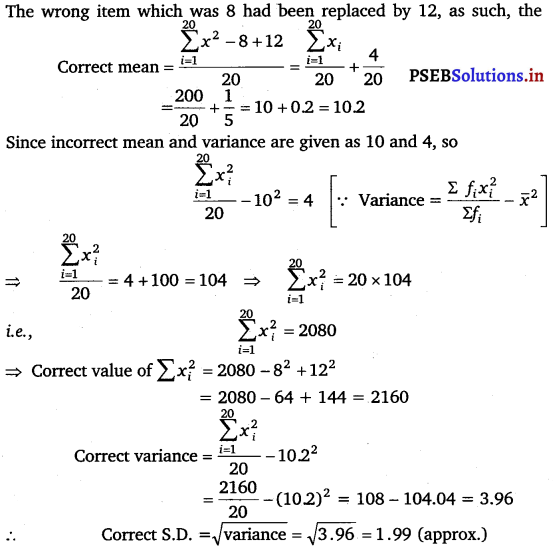Punjab State Board PSEB 11th Class Maths Book Solutions Chapter 15 Statistics Miscellaneous Exercise Questions and Answers.
PSEB Solutions for Class 11 Maths Chapter 15 Statistics Miscellaneous Exercise
Question 1.
The mean and variance of eight observations are 9 and 9.25, respectively. If six of the observations are 6, 7, 10, 12, 12 and 13, find the remaining two observations.
Answer.
Let the remaining two observations be a and b.
Given, \(\bar{x}\) = 9 and σ2 = 925
∴ \(\bar{x}\) = 9
⇒ Sum of all observations / Number of all observations = 9
⇒ Sum of all observations = 9 × 8 = 72
∴ Number of all observations = 8
⇒ 6 + 7 + 10 + 12 + 12 + 13 + a + b = 72
⇒ 60 + a + b = 72
⇒ a + b = 72 – 60
⇒ a + b = 12
Again, σ2 = \(\frac{\sum x_{i}^{2}}{n}-\left(\frac{\sum x_{i}}{n}\right)^{2}\)
⇒ σ2 = \(\frac{\sum x_{i}^{2}}{n}-(\bar{x})^{2}\)
9.25 = \(\frac{36+49+100+144+144+169+a^{2}+b^{2}}{8}\) – (9)2
9.25 = \(\frac{642+a^{2}+b^{2}}{8}\) – 81
9.25 + 81 = \(\frac{642+a^{2}+b^{2}}{8}\)
90.25 × 8 = 642 + a2 + b2
a2 + b2 = 722 – 642
a2 + b2 = 80 …………….(i)
Now, from eq. (1), putb = 12 – a in eq. (ii), we get
a2 + (12 – a)2 = 80
a2 + 144 + a2 – 24a = 80
2a2 – 24a + 144 – 80 = 0
2a2 – 24a + 64 = 0
a2 – 12a + 32 = 0 [divide both sides by 2]
a2 – 8a – 4a + 32 = 0
a (a – 8) – 4 (a – 8) = 0
(a – 4) (a – 8) = 0
a = 4 or a = 8
One putting a = 4 or a = 8 in eq. (i), we get
b = 8 or b = 4
Hence, observations are 4 and 8.
![]()
Question 2.
The mean and variance of 7 observations are 8 and 16, respectively. If five of the observations are 2, 4, 10, 12 and 14,
Find the remaining two observations.
Answer.
Let the remaining two observations be x and y.
Given, \(\bar{x}\) = 8, x1 = 2, x2 = 4 x3 = 10, x4 = 12 and x5 = 14.
⇒ \(\frac{x_{1}+x_{2}+x_{3}+x_{4}+x_{5}+x+y}{7}\) = 8
⇒ \(\frac{2+4+10+12+14+x+y}{7}\) = 8
⇒ 42 + x + y = 56
⇒ x + y = 14 ………………..(i)
Also, variance = 16
⇒ σ2 = 16
⇒ \(\frac{x_{1}^{2}+x_{2}^{2}+x_{3}^{2}+x_{4}^{2}+x_{5}^{2}+x^{2}+y^{2}}{7}-(\bar{x})^{2}\) = 16
⇒ \(\frac{2^{2}+4^{2}+10^{2}+12^{2}+14^{2}+x^{2}+y^{2}}{7}\) – (8)2 = 16
⇒ \(\frac{4+16+100+144+196+x^{2}+y^{2}}{7}\) – 64 = 16
⇒ \(\frac{460+x^{2}+y^{2}}{7}\) = 80
⇒ x2 + y2 = 7 × 80 – 460
= 560 – 460
x2 + y2 = 100
From eq. (i), y = 14 – x
Put this value of y in eq.(ii), we get
x2 + (14 – x)2 = 100
⇒ x2 +196 + x2 – 28x = 100
⇒ 2x2 – 28x + 96 = 0
⇒ x2 – 14x + 48 = 0 [divide both sides by 2]
⇒ (x – 6) (x – 8) = 0
⇒ x = 6, 8
From eq. (i),
If x = 6, then y = 14 – 6 = 8
If x = 8, then y = 14 – 8 = 6
Hence, the remaining two observations are 6 and 8.
![]()
Question 3.
The mean and standard deviation of six observations are 8 and 4, respectively. If each observation is multiplied by 3, find the new mean and new standard deviation of the resulting observations.
Answer.
Let the observations be x1, x2, x3, x4, x5 and x6.
Then, their mean, \(\bar{x}\) = \(\frac{\sum_{i=1}^{6} x_{i}}{6}\) = 8 [given]
\(\sum_{i=1}^{6} x_{i}\) = 8 × 6 = 48 …………….(i)
On multiplying each observation by 3, we get the new observation as 3x1, 3x2, 3x3, 3x4, 3x5 and 3x6.
Now, their new mean, \(\bar{x}\) = \(=\frac{\sum_{i=1}^{6} 3 x_{i}}{6}=\frac{3 \sum_{i=1}^{6} x_{i}}{6}\)
= \(\frac{3 \times 48}{6}\)
= 24 [from eq. (i)]
∴ Variance of new observation = \(\frac{\sum_{i=1}^{6}\left(3 x_{i}-24\right)^{2}}{6}\)
= \(\frac{3^{2} \sum_{i=1}^{6}\left(x_{i}-8\right)^{2}}{6}\)
= \(\frac{9}{1}\) × Variance of old observation
= \(\frac{9}{1}\) (4)2 = 144
[∵ given S.D. of old observation is 4]
Thus, S.D. of new observation = √(Variance) = √(144) = 2.
![]()
Question 4.
Given that \(\bar{x}\) is the mean and σ2 is the variance of observations x1, x2, ………….. xn. Prove that the mean and variance of the observations ax1, ax2, ax3, ……………., axn are a\(\bar{x}\) and a2 2 respectively,
Answer.
The given n observations are x1, x2, ………………., xn.
Mean = \(\bar{x}\)
Variance = σ2
∴ σ2 = \(\frac{1}{n} \sum_{i=1}^{n}\left(x_{i}-\bar{x}\right)^{2}\) ………………(i)
If each observation is multiplied by a and the new observations are yi then
yi = axi i.e., xi = \(\frac{1}{a}\) yi
∴ \(\bar{y}\) = \(\frac{1}{n} \sum_{i=1}^{n} y_{i}=\frac{1}{n} \sum_{i=1}^{n} a x_{i}\)
= \(\frac{a}{n} \sum_{i=1}^{n} x_{i}\) = a\(\bar{x}\)
(∵ \(\bar{x}\) = \(\frac{1}{n} \sum_{i=1}^{n} x_{i}\))
Therefore, mean of the observations, ax1, ax2, ax3, ……………., axn is a\(\bar{x}\).
Substituting the values of xiand \(\bar{x}\) in eq. (i), we obtain
⇒ σ2 = \(\frac{1}{n} \sum_{i=1}^{n}\left(\frac{1}{a} y_{i}-\frac{1}{a} \bar{y}\right)^{2}\)
a2 σ2 = \(\frac{1}{n} \sum_{i=1}^{n}\left(y_{i}-\bar{y}\right)^{2}\)
Thus, the variance of the observations, ax1, ax2, ax3, ……………., axn is a2 σ2.
![]()
Question 5.
The mean and standard deviation of 20 observations are found to be 10 and 2, respectively. On rechecking, it was found that an observation 8 was incorrect. Calculate the correct mean and standard deviation in each of the following cases :
(i) If wrong item is omitted.
(ii) If it is replaced by 12.
Answer.
(i) Number of observations (n) = 20
Incorrect mean = 10
Mean = \(\frac{\sum x_{i}}{n}\)
\(\frac{\sum_{i=1}^{20} x_{i}}{20}\) = 10
\(\sum_{i=1}^{20} x_{i}\) = 20 × 10 = 200
(i) Since the wrong item which was 8 has been omitted, the correct mean = \(\frac{\sum_{i=1}^{20} x_{i}-8}{19}\) because, on omitting the wrong item, the total number of observations left are 19.
∴ Correct mean = \(\frac{200-8}{19}=\frac{192}{19}\) = 10.11


![]()
Question 6.
The mean and standard deviation of marks obtained by 50 students of a class in three subjects, Mathematics, Physics and Chemistry are given below:

Which of the three subjects shows the highest variability in marks and which shows the lowest?
Answer.
Here, n = 50
For Mathematics
Given, \(\bar{x}\) = 42 and σ = 12
Coefficient of variation, (CV) = \(\frac{\sigma}{\bar{x}}\) × 100
= \(\frac{12}{42}\) × 100
= \(\frac{2}{7}\) × 100
= \(\frac{200}{7}\)
= 2857 ……………(i)
For Physics:
Given, \(\bar{x}\) = 32 and σ = 15
Coefficient of variation, (CV) = \(\frac{\sigma}{\bar{x}}\) × 100
= \(\frac{15}{32}\) × 100
= \(\frac{1500}{32}\)
= 46.87 ………………(ii)
For Chemistry:
Given, \(\bar{x}\) = 40.9 and σ = 20
Coefficient of variation, (CV) = \(\frac{\sigma}{\bar{x}}\) × 100
= \(\frac{20}{40.9}\) × 100
= \(\frac{2000}{40.9}\)
= 2000 = 48.89 ………………(iii)
From eqs. (i), (ii) and (iii), we have
CV of Chemistry > CV of Physics > CV of Mathematics
Hence, Chemistry shows the highest variability and Mathematics shows the least variability.
![]()
Question 7.
The mean and standard deviation of a group of 100 observations were found to be 20 and 3, respectively. Later on it was found that three observations were incorrect, which were recorded as 21, 21 and 18. Find the mean and standard deviation if the incorrect observations are omitted.
Answer.
Given, n = 100, \(\bar{x}\) = 20, σ = 3
∵ Mean, \(\bar{x}\) = 20
∴ \(\frac{\sum x_{i}}{100}\) = 20
⇒ Σxi = 100 × 20
⇒ Σxi = 2000
Now, incorrect observations 21, 21 and 18 are omitted, then correct sum is
Σxi = 2000 – 21 – 21 – 18 = 2000 – 60 = 1940
Now, correct mean of remaining 97 observations is \(\bar{x}\) = \(\frac{1940}{97}\) = 20
Again, σ = 3
⇒ \(\sqrt{\frac{\sum x_{i}^{2}}{n}-(\bar{x})^{2}}\) = 3
On squaring both sides, we get \(\frac{\sum x_{i}^{2}}{100}\) – (20)2 = 9
\(\frac{\sum x_{i}^{2}}{100}\) = 9 + 400 = 409
Σxi2 = 409 × 100 = 40900
Now, correct, Σxi2 = 40900 – (21)2 – (21)2 – (18)2
= 40900 – 441 – 441 – 324
= 40900 – 1206 = 39694
Now, correct standard deviation for remaining 97 observations is σ = \(\sqrt{\frac{39694}{97}-(20)^{2}}\)
= \(\sqrt{409.2-(20)^{2}}\)
= \(\sqrt{409.2-400}=\sqrt{9.2}\) = 3.03.
